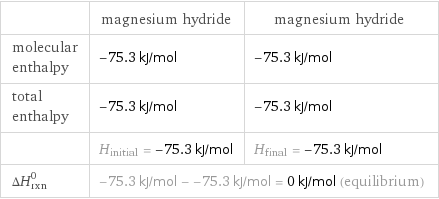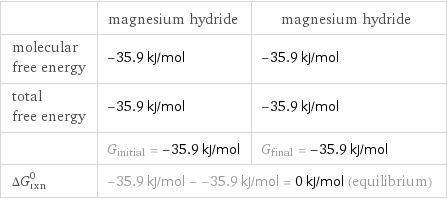Input interpretation

MgH_2 magnesium hydride ⟶ MgH_2 magnesium hydride
Balanced equation

Balance the chemical equation algebraically: MgH_2 ⟶ MgH_2 Add stoichiometric coefficients, c_i, to the reactants and products: c_1 MgH_2 ⟶ c_2 MgH_2 Set the number of atoms in the reactants equal to the number of atoms in the products for H and Mg: H: | 2 c_1 = 2 c_2 Mg: | c_1 = c_2 Since the coefficients are relative quantities and underdetermined, choose a coefficient to set arbitrarily. To keep the coefficients small, the arbitrary value is ordinarily one. For instance, set c_1 = 1 and solve the system of equations for the remaining coefficients: c_1 = 1 c_2 = 1 Substitute the coefficients into the chemical reaction to obtain the balanced equation: Answer: | | MgH_2 ⟶ MgH_2
Structures

⟶
Names

magnesium hydride ⟶ magnesium hydride
Reaction thermodynamics
Enthalpy

| magnesium hydride | magnesium hydride molecular enthalpy | -75.3 kJ/mol | -75.3 kJ/mol total enthalpy | -75.3 kJ/mol | -75.3 kJ/mol | H_initial = -75.3 kJ/mol | H_final = -75.3 kJ/mol ΔH_rxn^0 | -75.3 kJ/mol - -75.3 kJ/mol = 0 kJ/mol (equilibrium) |
Gibbs free energy

| magnesium hydride | magnesium hydride molecular free energy | -35.9 kJ/mol | -35.9 kJ/mol total free energy | -35.9 kJ/mol | -35.9 kJ/mol | G_initial = -35.9 kJ/mol | G_final = -35.9 kJ/mol ΔG_rxn^0 | -35.9 kJ/mol - -35.9 kJ/mol = 0 kJ/mol (equilibrium) |
Equilibrium constant
![Construct the equilibrium constant, K, expression for: MgH_2 ⟶ MgH_2 Plan: • Balance the chemical equation. • Determine the stoichiometric numbers. • Assemble the activity expression for each chemical species. • Use the activity expressions to build the equilibrium constant expression. Write the balanced chemical equation: MgH_2 ⟶ MgH_2 Assign stoichiometric numbers, ν_i, using the stoichiometric coefficients, c_i, from the balanced chemical equation in the following manner: ν_i = -c_i for reactants and ν_i = c_i for products: chemical species | c_i | ν_i MgH_2 | 1 | -1 MgH_2 | 1 | 1 Assemble the activity expressions accounting for the state of matter and ν_i: chemical species | c_i | ν_i | activity expression MgH_2 | 1 | -1 | ([MgH2])^(-1) MgH_2 | 1 | 1 | [MgH2] The equilibrium constant symbol in the concentration basis is: K_c Mulitply the activity expressions to arrive at the K_c expression: Answer: | | K_c = ([MgH2])^(-1) [MgH2] = ([MgH2])/([MgH2])](../image_source/1570b53e0e95e2e41b1d1dd6bfea6dd5.png)
Construct the equilibrium constant, K, expression for: MgH_2 ⟶ MgH_2 Plan: • Balance the chemical equation. • Determine the stoichiometric numbers. • Assemble the activity expression for each chemical species. • Use the activity expressions to build the equilibrium constant expression. Write the balanced chemical equation: MgH_2 ⟶ MgH_2 Assign stoichiometric numbers, ν_i, using the stoichiometric coefficients, c_i, from the balanced chemical equation in the following manner: ν_i = -c_i for reactants and ν_i = c_i for products: chemical species | c_i | ν_i MgH_2 | 1 | -1 MgH_2 | 1 | 1 Assemble the activity expressions accounting for the state of matter and ν_i: chemical species | c_i | ν_i | activity expression MgH_2 | 1 | -1 | ([MgH2])^(-1) MgH_2 | 1 | 1 | [MgH2] The equilibrium constant symbol in the concentration basis is: K_c Mulitply the activity expressions to arrive at the K_c expression: Answer: | | K_c = ([MgH2])^(-1) [MgH2] = ([MgH2])/([MgH2])
Rate of reaction
![Construct the rate of reaction expression for: MgH_2 ⟶ MgH_2 Plan: • Balance the chemical equation. • Determine the stoichiometric numbers. • Assemble the rate term for each chemical species. • Write the rate of reaction expression. Write the balanced chemical equation: MgH_2 ⟶ MgH_2 Assign stoichiometric numbers, ν_i, using the stoichiometric coefficients, c_i, from the balanced chemical equation in the following manner: ν_i = -c_i for reactants and ν_i = c_i for products: chemical species | c_i | ν_i MgH_2 | 1 | -1 MgH_2 | 1 | 1 The rate term for each chemical species, B_i, is 1/ν_i(Δ[B_i])/(Δt) where [B_i] is the amount concentration and t is time: chemical species | c_i | ν_i | rate term MgH_2 | 1 | -1 | -(Δ[MgH2])/(Δt) MgH_2 | 1 | 1 | (Δ[MgH2])/(Δt) (for infinitesimal rate of change, replace Δ with d) Set the rate terms equal to each other to arrive at the rate expression: Answer: | | rate = -(Δ[MgH2])/(Δt) = (Δ[MgH2])/(Δt) (assuming constant volume and no accumulation of intermediates or side products)](../image_source/bd69f431fa66278e11f431e35a2fefd7.png)
Construct the rate of reaction expression for: MgH_2 ⟶ MgH_2 Plan: • Balance the chemical equation. • Determine the stoichiometric numbers. • Assemble the rate term for each chemical species. • Write the rate of reaction expression. Write the balanced chemical equation: MgH_2 ⟶ MgH_2 Assign stoichiometric numbers, ν_i, using the stoichiometric coefficients, c_i, from the balanced chemical equation in the following manner: ν_i = -c_i for reactants and ν_i = c_i for products: chemical species | c_i | ν_i MgH_2 | 1 | -1 MgH_2 | 1 | 1 The rate term for each chemical species, B_i, is 1/ν_i(Δ[B_i])/(Δt) where [B_i] is the amount concentration and t is time: chemical species | c_i | ν_i | rate term MgH_2 | 1 | -1 | -(Δ[MgH2])/(Δt) MgH_2 | 1 | 1 | (Δ[MgH2])/(Δt) (for infinitesimal rate of change, replace Δ with d) Set the rate terms equal to each other to arrive at the rate expression: Answer: | | rate = -(Δ[MgH2])/(Δt) = (Δ[MgH2])/(Δt) (assuming constant volume and no accumulation of intermediates or side products)
Chemical names and formulas

| magnesium hydride | magnesium hydride formula | MgH_2 | MgH_2 Hill formula | H_2Mg | H_2Mg name | magnesium hydride | magnesium hydride
Substance properties

| magnesium hydride | magnesium hydride molar mass | 26.321 g/mol | 26.321 g/mol phase | solid (at STP) | solid (at STP) melting point | 327 °C | 327 °C density | 1.45 g/cm^3 | 1.45 g/cm^3
Units
